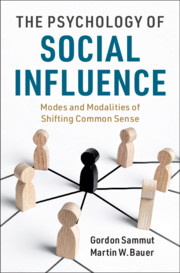Book contents
- The Psychology of Social Influence
- The Psychology of Social Influence
- Copyright page
- Dedication
- Contents
- Figures
- Tables
- Boxes
- Foreword 1
- Foreword 2
- Acknowledgements
- Chapter 1 Modalities of Social Influence
- Part I Recurrent Sources of Populism
- Part II Experimental Paradigms
- Part III Necessary Extensions
- Part IV Theoretical Integration
- References
- Index
Chapter 1 - Modalities of Social Influence
Preconditions (Public Sphere) and Demarcations (Non-violence)
Published online by Cambridge University Press: 19 December 2020
- The Psychology of Social Influence
- The Psychology of Social Influence
- Copyright page
- Dedication
- Contents
- Figures
- Tables
- Boxes
- Foreword 1
- Foreword 2
- Acknowledgements
- Chapter 1 Modalities of Social Influence
- Part I Recurrent Sources of Populism
- Part II Experimental Paradigms
- Part III Necessary Extensions
- Part IV Theoretical Integration
- References
- Index
Summary
The opening chapter charts the way from initial concerns with unruly crowds to contemporary social movements. It locates various modalities of social influence within interactive processes and different modes of communication. Social influence must be analysed in relation to a shifting common sense in line with aspirations of individuals or groups. The chapter steps back from an 'empiricist' treatment of social influence that has predominated in the field, and clarifies three conditions of possibility. Firstly, social influence is non-violent. Social influence seeks to institute claims about the world 'rhetorically', without the violence that turns might into right. Secondly, a functioning public sphere, and less the systems of markets and kinship, is the natural place of social influence. This, however, requires a reciprocal orientation before actors can seek to further their own interests. Thirdly, individual differences of citizen competences condition the prevailing social influences in a society. The chapter concludes with an overview of the chapters on the various modalities of social influence that have been investigated to date.
Keywords
- Type
- Chapter
- Information
- The Psychology of Social InfluenceModes and Modalities of Shifting Common Sense, pp. 1 - 24Publisher: Cambridge University PressPrint publication year: 2021



